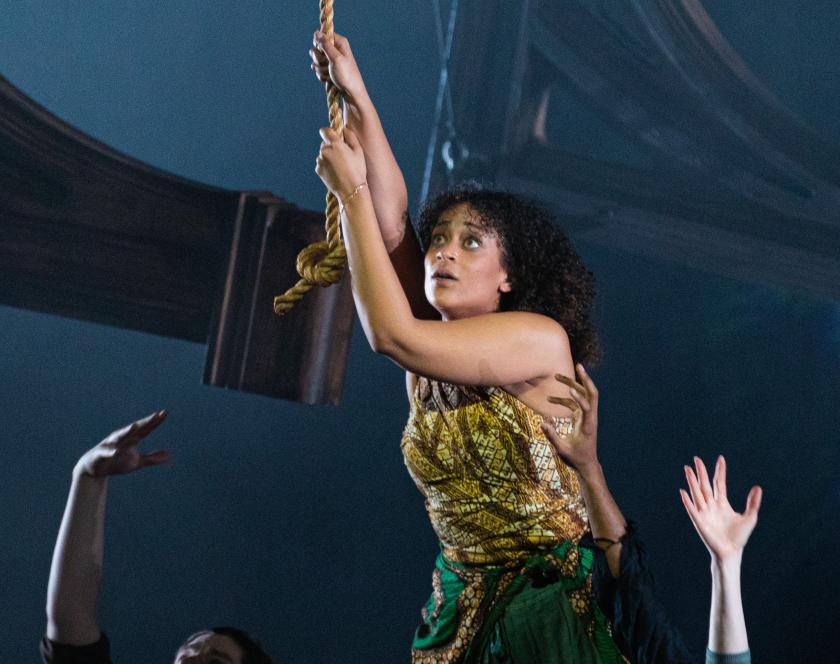There’s a moment in the opening stretch of Giles Terera’s The Meaning of Zong where you think the former Hamilton star has written a piece about slavery that’s in much the same idiom as the hit musical.
Music will indeed be a strong presence in this piece, but it is crafted around the songs of West Africa, lovingly supported by the playing of a djeli n'goni (a traditional Griot stringed instrument) by Sidiki Dembele. He is playing a drum when the audience enters and soon involves us in mirroring his rhythms with our clapping. This is the tenor of what follows: it’s theatre as an interactive act, as if a community play has arrived at the Barbican, intent on making the audience part of the storytelling. This was indeed the original aim of the piece at the Bristol Old Vic, a way of engaging the city’s inhabitants with its slaving history.
The story Terera is telling is not an unknown one: the massacre of 132 West Africans in the Caribbean in 1781, when the slave-ship transporting them to Jamaica, the Zong, lost its bearings, its captain being gravely ill and his second in command relieved of his duties after an argument. The water was running out, land was still 11 days away and the only recourse the remaining crew could see was to ditch those on board who needed the water most, the African women and children first, still chained.
Just as horrible as these deaths was the vile motive for them: to claim on the insurance when the ship returned to port. This money would be forfeited if any of the “cargo” reached land. The insurers refused to pay up, claiming the slaves were unlawfully killed, but a court ruled that as they constituted cargo, their loss had to be compensated for. But the insurers pressed presiding judge Lord Mansfield to hold a hearing, and new evidence persuaded him to retry the case. As the witness statements unfolded, the grim truths of the massacre were made public and the nascent abolitionist cause began to gain momentum.
 Instrumental in involving the anti-slavery campaigner Granville Sharp (Tristan Sturrock), who aided the insurers’ case, was a freedman, Gustavus Vassa (Terera, pictured left), captured by slavers in Benin when he was a young boy, then sold on several times until his talents were recognised by an owner who gave him a European name and an education, and employed him. Vassa earned enough money to buy his freedom. As the piece progresses, he is haunted by flashbacks of a young girl being kidnapped – his sister – and slowly his sense of his true identity and actual name returns.
Instrumental in involving the anti-slavery campaigner Granville Sharp (Tristan Sturrock), who aided the insurers’ case, was a freedman, Gustavus Vassa (Terera, pictured left), captured by slavers in Benin when he was a young boy, then sold on several times until his talents were recognised by an owner who gave him a European name and an education, and employed him. Vassa earned enough money to buy his freedom. As the piece progresses, he is haunted by flashbacks of a young girl being kidnapped – his sister – and slowly his sense of his true identity and actual name returns.
There is a strong storyline here that the production, co-directed by Tom Morris and Terera, goes all out to project. The staging is simple but inventive, with high overhead wooden brackets descending and flipping to create the hull of the Zong, and video projections creating a stained glass window on the back wall in the courtroom scenes, a roiling sea during the drownings. One striking scene has the cast holding long blue ropes which they jiggle, making the woman in the midst of them seem to be caught in a heavy swell. Each actor carries a wooden plank that will do stout service throughout as various kinds of ad hoc scenery, even something to thump the floor with.
The cast (including Terera) do multiple turns, though the focus inevitably falls on three of the women on board the Zong, whose plaintive singing evokes their homeland and whose dancing in beautiful, vibrant dresses and headgear is wild and impassioned. One is Ama (Kiera Lester), whom we have seen in the first scene as Gloria, a young modern-day campaigner against racial injustices who is visited by the shade of Vassa, drawn into the story he is telling and recast as a captive.
This time travelling element is presumably a way to connect the modern-day with the past, to ensure audience relatability. But it creates an uneven tone in the script, which here feels confected, even whimsical. In other places, it suddenly and puzzlingly erupts into fierce ideological spats between characters on the same side, as if to provide a way for them to air key points rather than deepen their characterisation. Though couched in a certain chumminess, a didactic strain runs through the piece, as if the audience aren't trusted to understand the magnitude of the issues they are being presented with.
But Terera's dialogue is also capable of delivering some telling slaps, such as the interchange Vassa has with Sharp where he tries to make the abolitionist put into words his belief that people of colour are exactly equal to white ones; otherwise, Vassa suggests, he will have no more status than a horse.
Vassa’s birth-name, he comes to realise, is Olaudah Equinia (under which name he wrote the first slave narrative in 1789), which means “one who speaks well and loudly”. It's a message the cast need to take to heart as the dialogue sometimes struggles to project clearly into the vast space of the Barbican Theatre auditorium. The show’s message about our need to recognise the abiding taint of slavery and to stand up to other such profound injustices couldn’t be louder and clearer, though.















Add comment